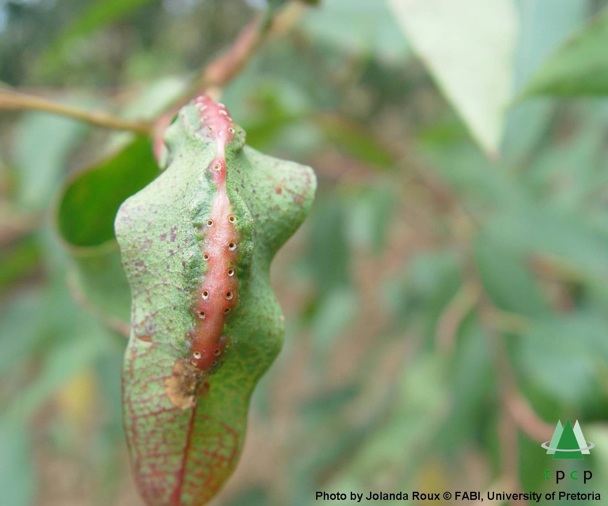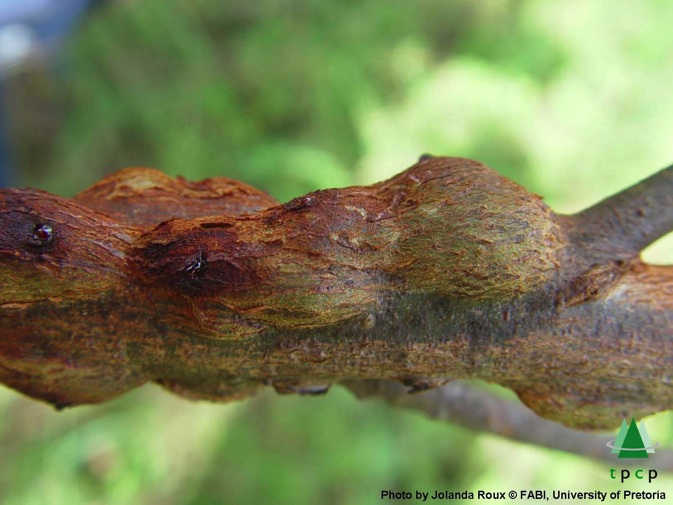PESTS AND DISEASES OF FORESTRY IN NEW ZEALAND
Leptocybe invasa
Scion is the leading provider of forest-related knowledge in New Zealand
Formerly known as the Forest Research Institute, Scion has been a leader in research relating to forest health for over 50 years. The Rotorua-based Crown Research Institute continues to provide science that will protect all forests from damage caused by insect pests, pathogens and weeds. The information presented below arises from these research activities.
From Forest Health News 217, July 2011
LEPTOCYBE INVASA, A GALL FORMING WASP ON EUCALYPTUS, NOT IN NEW ZEALAND
Leptocybe invasa is a small chacidoid wasp that causes galls on the leaf midribs, petioles and stems of new growth of young eucalyptus trees, coppice and seedlings. Heavily attacked trees suffer leaf fall, loss of vigour, stunted growth and dieback. Severe infestation can cause tree death.

Leptocybe invasa was first recorded in the Middle East in 2000 but was not described as a new species (and genus) until 2004. It is restricted to Eucalyptus spp. and because of this is almost certainly of Australian origin although its distribution there is unknown. It has been recorded from the following areas: Middle East: Iran, Israel, Jordan, Syria; Europe: France, Italy, Portugal, Spain, Turkey; Africa: Algeria, Kenya, Morocco, South Africa, Tanzania, Uganda; Asia: China, India, Thailand, Viet Nam; North America: Florida; South America: Brazil.
It attacks quite a range of Eucalyptus species including E. botryoides, E. bridgesiana, E. camaldulensis, E. deanei, E. globulus, E. gunnii, E. grandis, E. nitens, E.robusta, E. saligna E. tereticornis and E. viminalis.
An internet search will find at least two sites that say Leptocybe invasa is present in New Zealand. These are www.fao.org/docrep/012/al332e/al332e00.pdf and ftp.fao.org/docrep/fao/011/i0640e/i0640e10o.pdf. Both of these are United Nations Food and Agriculture Organization sites so, as one would expect, have a high profile. Over the past few years I have been asked by several people if L. invasa is present in New Zealand. It has not been found here and this can be said with a very high degree of confidence because for many years now eucalypts grown in New Zealand have been subject to very close examination in connection with work on the biological control of Paropsis charybdis (eucalyptus tortoise beetle) and Uraba lugens (gumleaf skeletoniser).

It would seem very likely that the records from New Zealand referred to above arise from the fact that L. invasa is commonly called blue gum chalcid. In New Zealand there is another gall forming wasp on eucalypts with the common name bluegum chalcid. This is Ophelimus eucalypti (formerly known as Rhicnopeltella eucalypti), an Australian species first found here in the early 1920s. Ironically the Australian distribution of O. eucalypti is not known, just as is the case with L. invasa. We will have to ask the Australians to stop exporting insects that they do not know they have!
John Bain
This information is intended for general interest only. It is not intended to be a substitute for specific specialist advice on any matter and should not be relied on for that purpose. Scion will not be liable for any direct, indirect, incidental, special, consequential or exemplary damages, loss of profits, or any other intangible losses that result from using the information provided on this site.
(Scion is the trading name of the New Zealand Forest Research Institute Limited.)

 Farm Forestry New Zealand
Farm Forestry New Zealand

